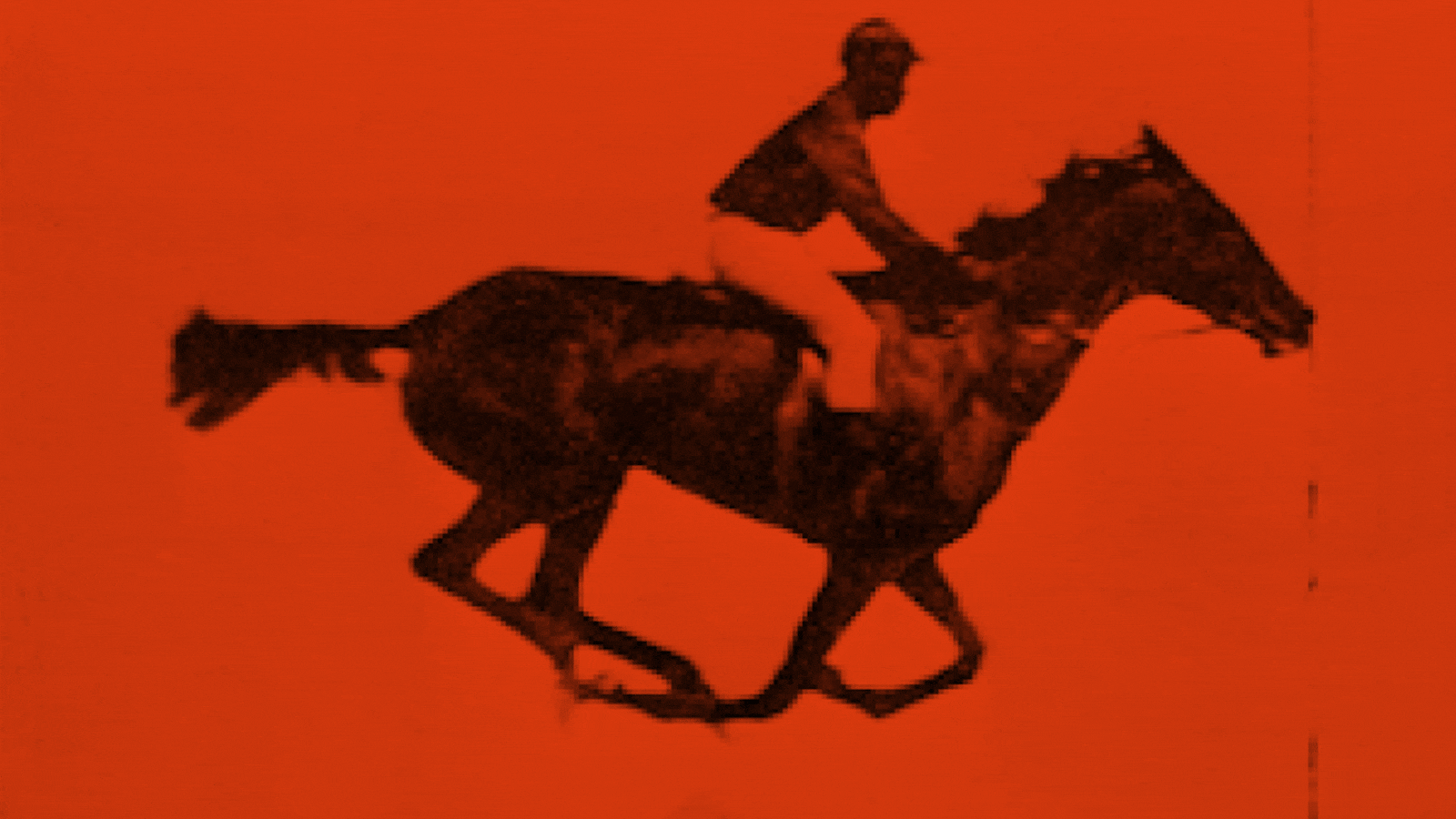The story behind The Horse in Motion—the so-called “first motion picture”—has almost as many twists and turns as Nope, Jordan Peele’s latest horror romp that references the series of cabinet cards showing a man riding a horse.
Nope stars Daniel Kaluuya and Keke Palmer as OJ and Emerald Haywood, two siblings who rent out horses for Hollywood productions. During a pitch to a crew, Emerald reveals she and her brother are descendants of one “Alistair E. Haywood,” the Black jockey who appears in what Emerald calls the very first movie.
This backstory comes full circle when the Haywoods take it upon themselves to capture another fast and unwieldy subject: a voracious UFO. Theirs is a mythical course-correction, with Peele giving kudos to the unidentified Black jockey whose likeness is immortalized as part of the early history of motion pictures. In the movie, his great-great-great grandchildren are struggling to keep the family business afloat despite being part of what should be Hollywood royalty.
Like any work of fiction, Nope took more than a few liberties with the story of The Horse in Motion.
For starters, the first assembly of pictures to recreate movement did not feature a Black jockey on a horse, according to four researchers and photography experts who spoke to The Daily Beast.
In 1872, Leland Stanford, the former governor of California and a horse aficionado, hired British-born photographer Eadweard Muybridge to photograph galloping horses at his property in Sacramento. The point was to prove that all four of a horse’s hooves are off the ground at one point. Legend has it that Stanford commissioned the experiment to settle a bet.
“Muybridge seems to have proved this to Stanford’s satisfaction, but the pictures were too fuzzy and imperfect to publish,” said photo historian and Muybridge expert Phillip Prodger in an email to The Daily Beast. “They exist now only in the form of drawn and corrected copies.”
This first set of photos did not feature Black jockeys. Muybridge and Stanford’s collaboration was suddenly interrupted in 1874, when the former traveled to the city of Calistoga to kill his wife’s lover, Major Harry Larkyns.
“After having discovered the affair, the photographer sought out his rival at the Yellow Jacket quicksilver mine where Larkyns worked as a surveyor; he greeted him with the words: ‘Here’s the reply to the letter you sent my wife’ and then shot him through the heart with his Smith & Wesson No. 2 revolver,” according to a 2014 article by film and media professor Ulrich Meurer in the journal Kinetophone.
In court, Muybridge pleaded insanity. He blamed the killing on an 1860 accident in which he hit his head against a boulder after he was thrown off a stagecoach, according to a 2002 article by psychology professor Arthur P. Shimamura in the journal History of Photography.
Though he admitted the murder was intentional, he was acquitted on the grounds of justifiable homicide in a dramatic verdict.
“At the sound of the last momentous words a convulsive gasp escaped the prisoner’s lips, and he sank forward from his chair. The mental and nervous tension that had sustained him for days of uncertain fate was removed in an instant; and he became as helpless as a new-born babe. Mr. Pendegast [his lawyer] caught him in his arms and thus prevented his falling to the floor, but his body was limp as a wet cloth,” according to a San Francisco Chronicle article from 1875.
Muybridge’s ex-wife Flora, who had divorced him, died five months after the trial. Their son was sent to an orphanage. The photographer spent time in what Prodger calls “self-imposed exile” in Central America before returning to the U.S.
By 1878, Muybridge and Stanford were back at it. The actual Horse in Motion cabinet cards were created that year at Stanford’s Palo Alto Stock Farm Horse Barn. The seismic effort required a series of 12 cameras set up parallel to a training track under a shed about 50 feet long, according to Muybridge: Man in Motion by Robert Haas. The cameras were triggered by trip wires.
“Fine black threads were placed across the track [and] connected so that the armatures would release the slides [shutters] as before. The racing mare ‘Sally Gardner,’ a handsome animal, was brought out and the threads placed so as to strike her breast as she went by,” explained a reporter from the Pacific Rural Press who had observed the spectacle.
Muybridge experts disagree as to whether the experiments resulted in motion pictures. The photos themselves could not yet be projected. They had to be drawn and placed inside Muybridge’s zoopraxiscope, thus making them more animations than movies.
“He was not taking a single film, but rather a series of still shots which were later projected in sequence,” said Brian Clegg, author of The Man Who Stopped Time: The Illuminating Story of Eadweard Muybridge — Pioneer Photographer, Father of the Motion Picture, Murderer. “This meant his approach would never be usable for long movies. Muybridge was using plate cameras, and to get longer movies required the development of the roll film.”
Reporters at the time called the feat a “great success” and debated over who deserved more credit—Muybridge for devising the setup or Stanford for financing it.
Regardless of how one labels the results, Ryerson University art professor Marta Braun says the Horse in Motion photos remain significant in the history of motion pictures.
“What he does is he makes drawings from them and he puts those on a glass wheel and uses a magic lantern, and the wheel spins and you get the first animation,” Braun told The Daily Beast. “The 1878 stuff he did for Stanford is the first time you could see the gaits of the horse.”
But the footage of the Black jockey on a horse that appears in Nope isn’t from The Horse in Motion or even from earlier experiments. It’s actually from a different sequence that appears in Muybridge’s folio titled Animal Locomotion. The photos were taken in Philadelphia in the mid-1880s during his time working at the University of Pennsylvania. They were part of a series that included photos of dancing, naked bodies published in 1887, about 15 years after he first paired up with Stanford. The horse in this set is identified as Annie G.
As for the identity of the jockeys? Sadly, the names have been lost to time. Charles Marvin is identified as one of the men who rode a buggy attached to the horse, but the jockeys on top of the horse are not named. Alistair E. Haywood is nothing but a fiction created by Peele to give his characters a meaningful history and motivate their pursuit.
“At least one of the jockeys in the Horse in Motion series (the Sallie Gardner running picture) appears to have been African American and probably was (many of the best jockeys of the day were African American) but it’s really hard to prove, because we know next to nothing about any of the jockeys, and because of the nature of the early process, all the faces in the earliest pictures are in silhouette,” said Prodger.
“The main point is that African American men were a vital part of horse-racing culture in the late 19th century, their contributions are seldom acknowledged, and their identities are mostly lost to history,” he added.
Marc Shaffer, a documentarian who won a Writers Guild of America Award for his 2021 film Exposing Muybridge, says the Horse in Motion horses were actually ridden by white men.
“There’s a lot of confusion about the Muybridge history here, as Nope doesn’t quite get it right (which isn’t a crime, since it’s a fictional film after all),” Shaffer told The Daily Beast in an email.
In the film, Emerald ends up racing to a nearby carnival to capture the horrifying UFO with an analog plate camera, an obvious allusion to the technology used by Muybridge to “film” their fictional great-great-great-grandfather.
Along with Hollywood, Braun says Nope touches on yet another industry where Black people’s contributions have been historically sidelined.
“The whole history of black jockeys and how they could make money in the early 1880s, until the white people figured out that it was financially lucrative and then marginalized it, that’s a very interesting story.”

